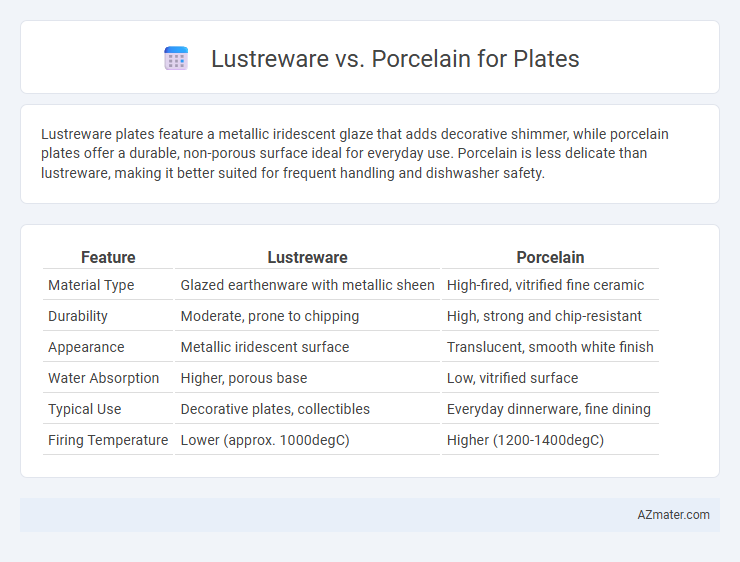Lustreware plates feature a metallic iridescent glaze that adds decorative shimmer, while porcelain plates offer a durable, non-porous surface ideal for everyday use. Porcelain is less delicate than lustreware, making it better suited for frequent handling and dishwasher safety.
Table of Comparison
| Feature | Lustreware | Porcelain |
|---|---|---|
| Material Type | Glazed earthenware with metallic sheen | High-fired, vitrified fine ceramic |
| Durability | Moderate, prone to chipping | High, strong and chip-resistant |
| Appearance | Metallic iridescent surface | Translucent, smooth white finish |
| Water Absorption | Higher, porous base | Low, vitrified surface |
| Typical Use | Decorative plates, collectibles | Everyday dinnerware, fine dining |
| Firing Temperature | Lower (approx. 1000degC) | Higher (1200-1400degC) |
Introduction to Lustreware and Porcelain
Lustreware, characterized by its metallic glaze, offers a lustrous finish achieved through a unique firing process involving metal oxides, creating an iridescent sheen prized in decorative plates. Porcelain, made from refined kaolin clay fired at high temperatures, provides a translucent, durable, and non-porous surface ideal for both everyday use and fine dining. Both materials reflect distinct manufacturing techniques and aesthetic qualities, with lustreware emphasizing ornamental appeal and porcelain valued for its strength and smooth texture.
Historical Origins and Development
Lustreware originated in the medieval Islamic world around the 9th century, showcasing a distinctive metallic glaze achieved through delicate firing techniques that spread to Europe by the 15th century, particularly in Italy and England. Porcelain, developed in China during the Tang dynasty (7th-10th centuries) and perfected in the Ming dynasty, is characterized by its high-fired, vitrified, and translucent quality, which revolutionized pottery and trade worldwide. The historical trajectory of lustreware highlights artistic glazing innovations, while porcelain's development emphasizes technical mastery and durability, both shaping the cultural and commercial landscape of ceramic plates.
Material Composition and Manufacturing
Lustreware plates feature a metallic glaze created by applying metal oxides during a second firing process, resulting in an iridescent finish on a ceramic base typically composed of earthenware or stoneware. Porcelain plates are made from a refined clay mixture including kaolin, feldspar, and quartz, fired at higher temperatures to achieve a dense, vitrified, and translucent material. The manufacturing of lustreware emphasizes decorative glazing techniques, while porcelain production focuses on precise firing conditions to ensure strength, durability, and whiteness.
Visual Appearance and Decorative Styles
Lustreware plates feature a distinctive iridescent sheen created by metallic glazes, offering a shimmering visual appearance that changes with light and angle, making them ideal for decorative, statement pieces. Porcelain plates, known for their smooth, translucent white surface, provide a classic and elegant backdrop suited for intricate hand-painted designs, detailed patterns, and fine china aesthetics. The choice between lustreware and porcelain depends on whether the desired decorative style emphasizes radiant, reflective qualities or refined, delicate artistry.
Durability and Practical Use
Lustreware plates, known for their iridescent metallic glaze, offer moderate durability but are more prone to chipping and fading compared to porcelain. Porcelain plates provide superior strength, resistance to scratches and thermal shock, making them ideal for everyday practical use and frequent dishwasher cycles. For long-lasting tableware with consistent performance, porcelain is the preferred choice over lustreware in terms of durability and usability.
Maintenance and Care Requirements
Lustreware plates require gentle hand washing with mild detergents to preserve their metallic finishes, avoiding abrasive materials that can cause scratches or fading. Porcelain plates are generally more durable, often dishwasher-safe, and resistant to chipping and staining, making maintenance simpler for everyday use. Both materials benefit from careful storage to prevent damage, but porcelain offers greater convenience due to its higher resistance to wear.
Cost and Accessibility
Lustreware plates generally cost less than porcelain due to their simpler manufacturing process and the use of less expensive materials, making them more accessible for budget-conscious buyers. Porcelain plates, known for their durability and elegant finish, often come at a higher price point, reflecting their premium quality and longer lifespan. Accessibility to lustreware is higher in antique markets and specialty stores, while porcelain is widely available in both retail and online outlets catering to a range of budgets.
Collectibility and Value
Lustreware plates, known for their iridescent metallic glaze, often attract collectors due to their unique shimmer and historical production periods, particularly from the late 19th to early 20th century, making them potentially more valuable in niche markets. Porcelain plates, prized for their durability, fine craftsmanship, and association with famous manufacturers like Meissen or Wedgwood, generally command higher prices in the general collectibles market due to their timeless appeal and rarity. The value of both Lustreware and porcelain plates depends on factors such as maker's marks, condition, and provenance, with limited editions or artist-signed pieces significantly increasing collectibility.
Popular Uses in Modern Tableware
Lustreware offers a distinctive iridescent finish that is favored for decorative plates and special occasion dinnerware, adding elegance and reflective beauty to modern table settings. Porcelain plates are widely popular for everyday use due to their durability, non-porous surface, and ability to withstand high temperatures, making them ideal for both casual dining and formal events. The combination of aesthetic appeal in lustreware and the practical functionality of porcelain defines their respective roles in contemporary tableware collections.
Choosing Between Lustreware and Porcelain Plates
Choosing between lustreware and porcelain plates depends on desired aesthetics and durability; lustreware offers a distinctive metallic sheen and decorative appeal, while porcelain provides a classic, durable, and chip-resistant surface ideal for everyday use. Lustreware plates demand careful handling due to their delicate finish, contrasting with porcelain's strength and microwave-safe properties. Consider the intended use and maintenance requirements to select the best option for dining or display purposes.

Infographic: Lustreware vs Porcelain for Plate
 azmater.com
azmater.com